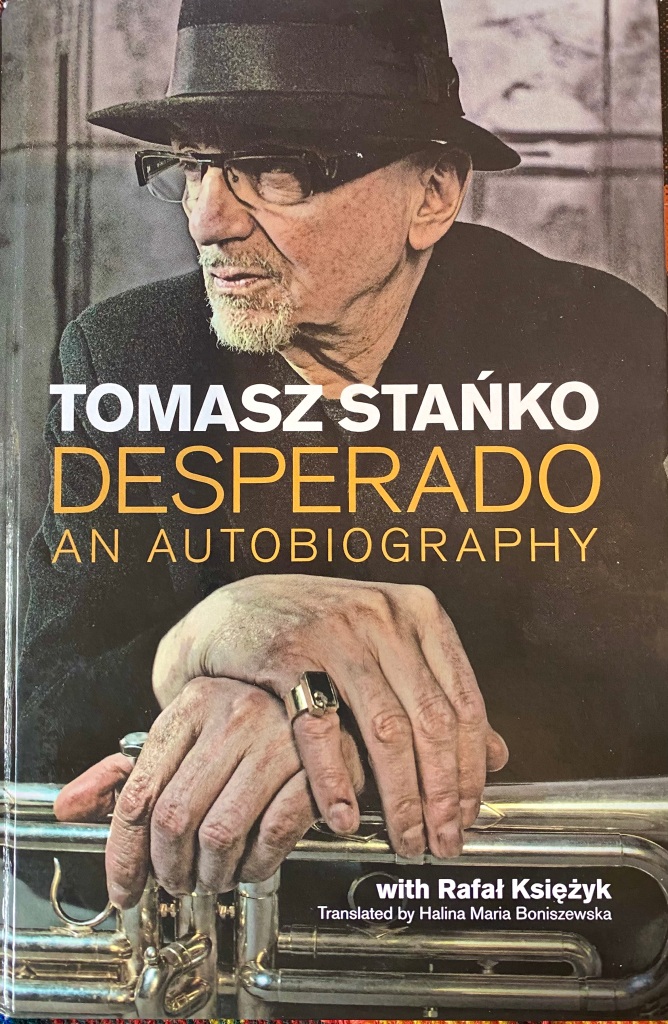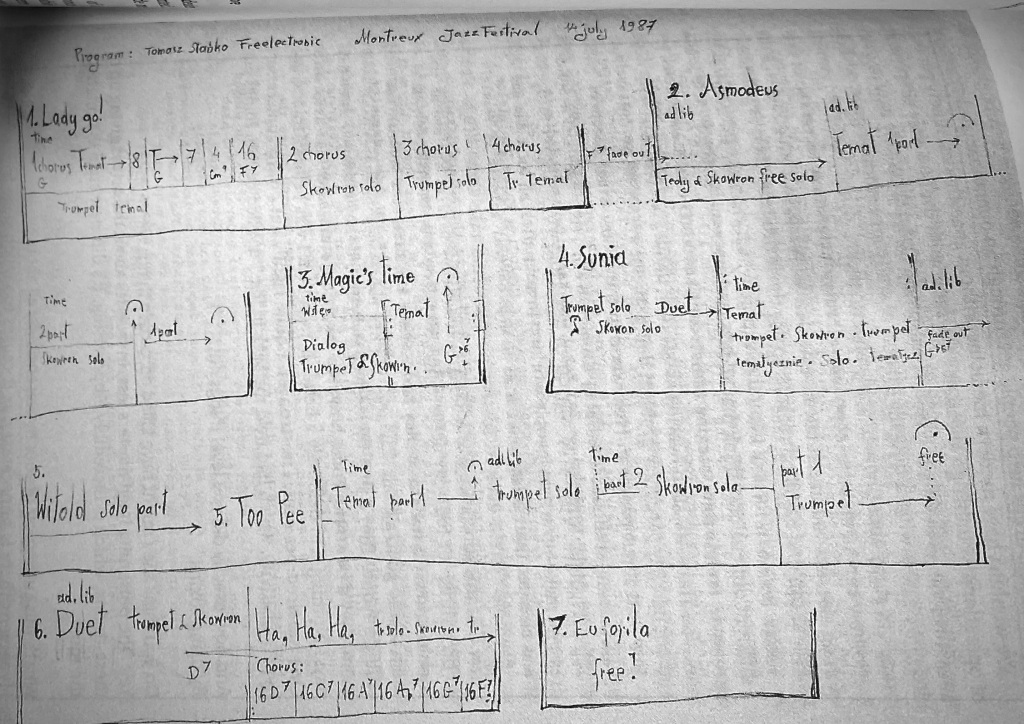
This post is the first of two book reviews. The books I review dovetail as they are part of the same story. Tomasz Stańko and Krzysztof (Komeda) Trzciński were bandmates, but they were more than that. They were innovators and extraordinary musicians, leaving behind them a rich legacy. One that is rightly elevating them to positions of greater significance. Anyone who watched the Homeland series on TV will be familiar with Stańko’s music, even if they don’t know his name. With Komeda, it is the same as his film themes live on in memory.
My grandmother was Polish. She would probably have disliked the music these musicians created. That combination of melodicism edging on dissonance, but that said, she would have recognised the Slavic modes and rhythms underlying it. Their music draws on the themes and modes of Cold War Poland. You hear fragments of marches, eastern European rhythms, and mostly, you can detect a melancholic filmic quality
I admit to an obsession with Komeda and an enduring one, but why? After all, he only officially released one jazz recording, Astigmatic. That single recording was enough to secure his place in the jazz pantheon, and, like so many others, I was bewitched at first hearing. It begged the question; how could such extraordinary music emerge from such difficult conditions? Jazz in Poland during the Soviet era was either forbidden or marginalised by the state apparatus. The two books I review here provide rare insights into those times by opening a window into the creative life of an extraordinary group of musicians and their willing enablers.
For years the only sources of information about this era were articles written for papers like the Guardian or Jazz magazines. Fascinated, I wanted to learn more about Krzysztof ‘Komeda’ Trzciński and Tomasz Stańko, so when the English language editions of these two books appeared, I ordered them immediately. They did not disappoint. Each has a different style; one an autobiography, a prompted stream-of-consciousness recollection, the other relying on interviews with musicians, fans and filmmakers (plus assorted private archives).
Tomasz Stanko, Desperado, an autobiography:
The compelling thing about this autobiography is the easy narrative flow. Throughout, Stańko responds fulsomely to the occasional prompts of interviewer Rafał Księżyk. He is a natural communicator, his responses taking us deep inside his creative process. And, unlike Komeda, who was shy and hated interviews, Stańko bares his soul, never dodging awkward topics.
Interviewer: ‘What attracted you to jazz?
Stańko: I realise now that I have a penchant for the unstable, the anarchic…this is all nonconformist music.
And on life in Soviet Poland,
“The Vodka flowed like a river. During communism, people drank because what else was there to do?
When he smoked a joint for the first time, he said: ‘Well, bugger me: that’s my thing”.
He was desperately poor during his early years as a musician and often homeless, but notwithstanding that, he was a deft navigator when it came to pursuing his musical dreams. He recalls sleeping in a basement storeroom underneath the Klub Hybrydy in Warsaw, where friends had painted a window on a wall to make it more bearable. Musicians were not considered productive and so were not entitled to the accommodation privileges provided to others by the state.
He began discreetly gigging while still in high school, as jazz was only tentatively emerging from the forbidden and moving into the ‘jazz catacomb’ era. He describes the jazz of that era as a hybrid Trad, rapidly moving towards modern. Like Trzciński (Komeda) he taught himself jazz by covertly listening to Conover’s Voice of America. When he joined the Komeda Quintet a few years later, he and many others had moved through the ‘modern’ styles to become free players (creating a Euro-free style). On this topic, he is illuminating.
Regarding his free-jazz album TWET:
‘I’d laid the groundwork for the quintet. Even the older musicians like Wojciech Karolak who didn’t like free, respected my music. And then playing free became widespread (in Poland). Nowadays, young musicians, whether they’re capable of it or not, are keen to play ‘free’. The less capable the keener they are. Not everybody does it well.

Later
‘Something that had begun in Europe, which they didn’t have in the States. It was a joining-together of melodic playing and free . . . A rather unconventional kind of scale and the particular application of two voices. My signature language is not so much based on scales as on a certain melodic atonality . . . my aesthetic imposes this otherness and accentuates it. I move into the realm of beauty, but at the same time, break it up completely, finding myself in a different world. All my compositions and ballads employ simple ideas, but sometimes a counterpoint will appear that knocks everything sideways. You don’t always hear it consciously, but it works underneath”.
And this.
“When we played (free) in the quintet, we completely switched off. Everything worked based on intuitive listening. We were sensitive to delicate nuances which gave us some kind of form to latch onto. Whole structures emerged: some sort of symphony began to take form. But there is a problem with pure improvisation. It is simply the best type of music – if it works. Only, unfortunately, it is beyond our control and so it doesn’t always work. I have had moments of complete freedom and played at my best, except the best moments playing free can’t be repeated. My style (today) uses free with some form.
He explains that, while they were not playing jazz exactly like the Americans, it came from a related set of circumstances. It may have been different, but of all the European nations, the Poles understand best what oppression means. Polish history can be summarised as a thousand years of suffering. The word Slav is the origin of the word slave.
‘It was a different aesthetic and even though it was an American art form, we had been cut off from the black experience. We had another set of difficult conditions and it is those difficult conditions that created our artists. Free jazz was a kind of underground. It was theatrical as well and it appealed to young people. I sometimes felt a bit strange on the scene, with my romantic melodiousness, but I survived because of the quality of my sound.
There is no bitterness in these recollections, telling Księżyk that he found constant pleasure in the richness of life. He did not like Moscow-styled communism but considered himself a lifelong lefty.
“I would argue about Communism (as opposed to Socialism) with John Surmon, Peter Brotzmann and Tony Oxley. I’d say it (communism) was all crap. The most interesting people in the West were those with leftist intentions. They were always my best friends and the finest people: intelligent, open, tolerant, and modern, artistically. They were lefties, and it’s still like that. The right in the artistic field is inextricably linked to failure, compromise, a lack of talent.”
Throughout, he comes across as thoughtful and self-aware. As the reader, you are the privileged voyeur, almost holding your breath, not wishing to break the spell. Learning about the structure of his music, gaining insights into his motivations, and sensing what it was like to be an impoverished Soviet-era jazz musician.
He describes himself as definitely optimistic but with a melancholic nature. He goes on to explain that all Polish music of those times was melancholic. His fellow musicians give a name to this which is zal. Zal is a nostalgia for what you never had – a very Polish concept.
‘(Music) deals with the order of things in its ‘own’ way. It doesn’t need any questions, any words or any conclusions. Creating new worlds and beauty… a state that is both mystical and deep… And which we celebrate without posing those big unanswerable questions.
‘Magic is in the same domain as art. It exists in the mind, externalises itself, interacts with the outside world… Rhythm produces trance, and trance is a response to unease. So we create new worlds and artistic beauty. Improvising is about transcendence.
‘I play motifs, maybe two and then open them out. I create (a) mood, then the magic arrives and I’m lost deep inside the music.
Stańko was a musical mystic, extremely knowledgeable about art, poetry, philosophy, the cosmos and science. He draws upon these themes constantly. We learn that he would often visit a galley and sit in front of a painting for weeks until a new tune or album emerged (Dark Eyes). Or contemplate a poem for a long time. An example of this is Wisława, dedicated to his friend the Nobel Laureate poet Wisława Szymborska. He was also fascinated by philosophy.
He had a fruitful, collaborative and enduring relationship with ECM as well, and his high regard for Manfred Eicher is evident throughout. For fans of ECM these accounts will be illuminating.
I lingered over his every recollection. Chuckled when he described how the Polish free players improvised during the inaugural performance of Penderiki’s modern classical masterpiece, much to his consternation, but the last paragraph was the one I liked the best. The place where I felt that I glimpsed his essence.
‘I am going to keep moving forward because there is a space ahead of me. Like those Portuguese sailors in Lisbon, who stood looking out at the ocean, knowing there is something out there but didn’t know what. They sailed not knowing what but believing that there was something wonderfully mysterious. I still have that sense of mystery knowing that musically something strange is going to happen, that I will be moving into areas (previously) unknown to me. And that is where I will be found.
I have read a lot of Jazz autobiographies and biographies over the years but seldom has a biography spoken to me as powerfully as this. Maybe it was the geek in me, delighting in the words and thoughts of a musician I love. Whatever, I strongly recommend it. Play the albums as they are mentioned and follow a profound musical journey. A very Cold War journey towards freedom and release.
The English edition is published by Equinox (Series editor by Alyn Shipton, Royal Acadamy of Music, London. Tomasz Stańko is interviewed by Rafał Księżyk, translated by Halina Maria Boniszewska.
Disclaimer: the tenses and word order can be different in Polish and this comes across in the quotes. I have mostly kept them intact. Acknowledgment: The photos used from the book are credited to Anna Stańko.
JazzLocal32.com is rated as one of the 50 best Jazz Blogs in the world by Feedspot. The author is a professional member of the Jazz Journalists Association, a Judge in the 7VJC International Jazz Competition, and apoet & writer. Some of these posts appear on other sites with the author’s permission.